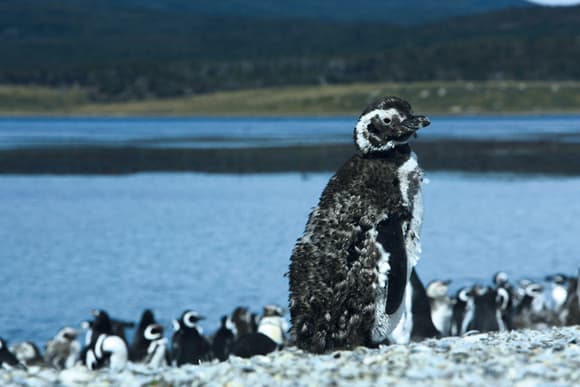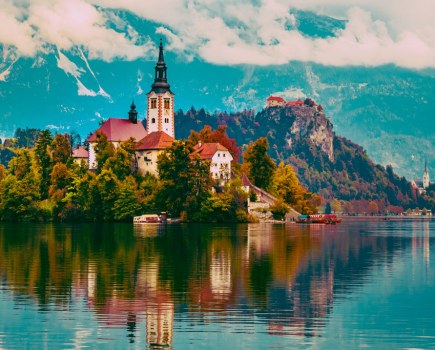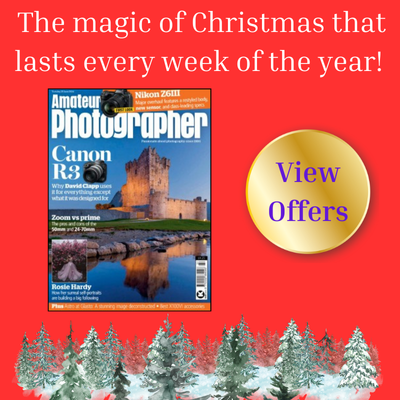Telephoto lenses do more than just bring distant objects nearer. Used creatively they can enhance your photography and alter the appearance of a wide range of subjects.

You can alter the effectiveness of the background, and so the overall composition, by changing from wideangle to telephoto lens. The picture above was taken with a 200mm lens: the background has been brought forward and the contours of the mountain make an interesting background.
With digital SLR cameras the choice of lenses is enormous and at the telephoto end of the range, lenses as long as 1200mm are available. With such a narrow field of view, ultra telephoto lenses might have their limitation, but for wildlife, sports and certain aspects of fashion photography they are in a field of their own. Telephoto lenses longer than 200mm tend to be very expensive and, unless you are going to specialise in one of the above areas, they are probably beyond the pocket of most amateur photographers. But if there is an occasion when the use of one is essential, they can be hired from a pro supplier such as Calumet.
 Suitably compressed
Suitably compressed
One of the advantages that telephoto lenses have is their ability to ‘compress’ your picture. This means that the space between what is close to the camera and what is far away diminishes. This can be used to enhance the compositional qualities of your shots, as can be seen here in this shot of the old San Francisco in the foreground and the newer Downtown area in the distance. I took this using a 400mm lens. The greater the focal length, the more the perspective will be compressed.
The most important thing to look out for when using a long telephoto is camera shake. A good rule of thumb is that if you are using a lens with a focal length of 100mm you should be using a shutter speed of at least 1/125th second. On the other hand, a lens with a focal length of 200mm will require a shutter speed of 1/250th second and so on. If you do not have a lens with an image-stabilising mode then you will have to support it in some way. An alternative to a tripod could be a monopod. This is the preferred choice for many pro sports photographers. In most cases longer lenses will require larger filters as the front lens element can increase dramatically, especially with fast lenses. Because of this, some ultra telephotos have a system for slip-in filters nearer to the camera body.
While many photographers will be using zoom lenses, consideration needs to be given to the ‘speed’ of the lens. This refers to the maximum possible aperture and not the shutter – though there is a correlation between the two. A lens with a maximum aperture of f2.8 will be faster than a lens that has only a maximum aperture of f5.6. Many zooms have a maximum aperture of f3.5 when the lens is at its widest focal length, but becomes f5.6 when zoomed to telephoto. This will necessitate using a slower shutter speed (which could result in camera shake) or increasing the ISO (which might result in an increase in noise). While these lenses can be moderately priced, the quality will always be inferior to a lens with a fast maximum aperture throughout its focal lengths.
 Blur the background
Blur the background
Telephoto lenses have a far less depth of field than standard or wideangle lenses. This means that you’ll be able to photograph subjects that are far away from the lens and bring them so that they appear closer and fill the frame. At the same time if you choose a wide aperture, f2.8 for example, the background will become quite blurred. This will make your main subject stand out with greater clarity while the background will become an attractive mottled range of hues. On the other hand, if you want greater depth of field you’ll have to stop the lens down to f16 or f22 and increase the shutter speed. Depending on the focal length of the telephoto that you are using, the shutter speed required might be too long for you to hold the camera steady so you’ll have to use a tripod; unless of course you are using an image-stabilising lens such as my Canon 70-200mm f2.8.
Long telephoto lenses, such as the 300mm I used to create this shot, can isolate the subject against the background. By using a wide aperture, such as f2.8, the area of sharp focus is extremely small and extends only a short way in front of and behind the model.
Guide to Telephoto Lenses – Useful gear
 Eye for detail
Eye for detail
Besides bringing distant objects closer, telephoto lenses are also very useful for cropping out unwanted detail. For this shot of an inner city tower block I used a 400mm lens which enabled me to get in tight so that the strong geometrical lines of the building are emphasised.
Filter
Haze, caused by ultraviolet radiation, is a bigger problem with longer telephoto lenses. A UV filter will improve clarity.
Tripod
Long lenses will need support if you’re to avoid camera shake – and possibly backache. A tripod is ideal.
Monopod
Monopods are a good compromise when a tripod is too big to carry. They provide good support but you can’t let go of them!
Extender
Cheaper than buying a super-telephoto lens, extenders increase the focal length by 1.4x or 2x, but with some loss of brightness.
Lenshood or Shade
Flare is a bigger risk with large front elements, so a lens hood is vital to keep out peripheral light.
 Using an extender as an alternative
Using an extender as an alternative
An alternative to an ultra telephoto is the use of an extender. Depending on the manufacturer, these come in different strengths. The one that I always use with my Canon kit is the 2x extender. When I fit this to my 70-200mm lens it gives me a maximum telephoto equivalent of 400mm. The only drawback is that I lose some speed as the maximum aperture available falls from f2.8 to f5.6.
So far I haven’t found this to be such a drawback and, when you take into consideration the cost factor, it is a piece of kit well worth having. Both the autofocus and image-stabilising elements of the lens still work when using the extender. If you consider that this extender costs under £300 and a 400mm f/5.6 lens costs nearly £1000 you can see why it’s such an economical alternative.
John’s Top Tips for Telephoto Lenses
- 1. Use wide apertures to your advantage by making the background go out of focus, thereby giving greater emphasis to your subject.
- 2. Because long telephoto lenses compress your shot, interesting effects can be achieved which will enhance your composition.
- 3. Although telephoto lenses have less depth of field than normal or wideangle lenses it is still possible to increase this by stopping down to f22 or even f32.
- 4. Use the shutter priority setting on your camera. This allows you to select the shutter speed while the camera selects the aperture. This gives you far
greater control over camera shake. - 5. When using these lenses to track subjects that are moving towards or away from the lens, use the AI Servo function to keep the subject pin sharp.

With subjects such as sport and wildlife you might find yourself some distance from your subject and have to use an ultra telephoto, such as the 600mm used here. Because of the lens size I used a monopod to keep the equipment steady and avoid camera shake.









